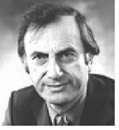About
In Memoriam: Daniel J. Bradley,
Feb 07, 2010
In Memoriam: Professor Daniel Bradley, laser scientist, 1928-2010

Daniel J. Bradley, an OSA Fellow and a member for 45 years, died 7 February 2010 in Sandymount, Dublin, Ireland. He was 82.
Bradley was an early pioneer and world leader in laser physics who was best known for his work on the development of ultra-fast pulsed lasers and high-efficiency dye lasers. Bradley produced pulses of laser light as short as one-millionth of one-millionth of a second (a picosecond), and he played a key role in the development of techniques to measure these short pulses, in particular using a device known as a streak camera.
Daniel Joseph Bradley was born on in 1928 in Londonderry, Northern Ireland. He was educated at St Columb’s College, Londonderry, and St Mary’s Training College, Belfast, qualifying as a teacher in 1947. He taught for several years in a primary school in Londonderry. At the same time, he enrolled at the University of London to study for an external B.Sc. degree in mathematics, which he received in 1953. He then taught mathematics in a grammar school in London from 1953 to 1957. While doing so he took evening courses in Birkbeck College, University of London. In 1957, he was awarded a B.Sc. in physics, achieving the highest marks in his final examinations in the whole university.
In 1957, having finally decided on a career in physics, he moved to Royal Holloway College, where he took his Ph.D. in 1961. Bradley’s academic career in physics began a bit later than usual but his progress after 1961 was unusually rapid. In 1960, he was appointed lecturer in physics at Imperial College, London. In 1964, he was appointed a reader in physics at Holloway College. In 1966, he was appointed professor of pure and applied physics at Queen’s University, Belfast.
At Queen’s University he rapidly established a large laser research group that achieved an international reputation. In 1973, he returned to Imperial College as professor of optics and again established a world-renowned research group.
Between 1976 and 1980, Bradley served as head of the physics department at Imperial College. He also helped establish the Central Laser Facility at the Rutherford-Appleton Laboratory, Didcot, Oxfordshire.
In 1980, he returned to Ireland to become professor of optical electronics at Trinity College, Dublin. He established a thriving research group at Trinity, his third.
In 1984, he suffered a serious stroke that forced him to retire prematurely, although he continued to participate in the academic life of Trinity College and to travel extensively. He was made Emeritus Professor by London University and by Trinity College, Dublin.
Bradley published more than 200 scientific papers in scholarly journals during his career. He was the recipient of numerous honors and awards, including the Royal Society’s Royal Medal (1983), the Institute of Physics’ Thomas Young Medal (1975), OSA’s Charles Hard Townes Award (1989), and the Royal Irish Academy’s Cunningham Medal (2001). He was elected an OSA Fellow in 1975, and he was also a Fellow of the Royal Society (1976), a Member of the Royal Irish Academy (1969), and a Fellow of the Institute of Physics (1959). He received honorary doctorates from the New University of Ulster (1983) and Queen’s University Belfast (1986).
He is survived by his wife, four sons and a daughter.
To make a contribution to the OSA Foundation in Prof. Bradley�s honor, please visit www.osa-foundation.org/give.
This obituary was contributed by The Times Online (UK).
